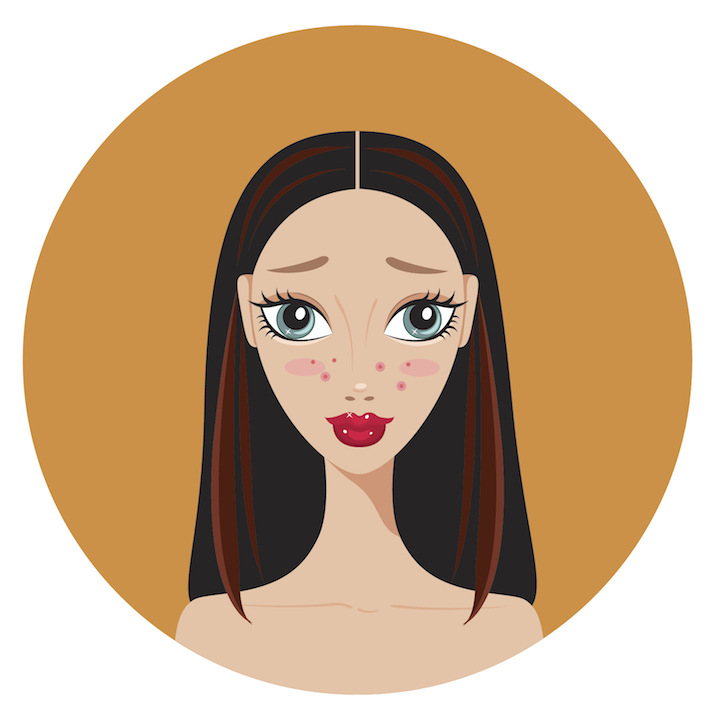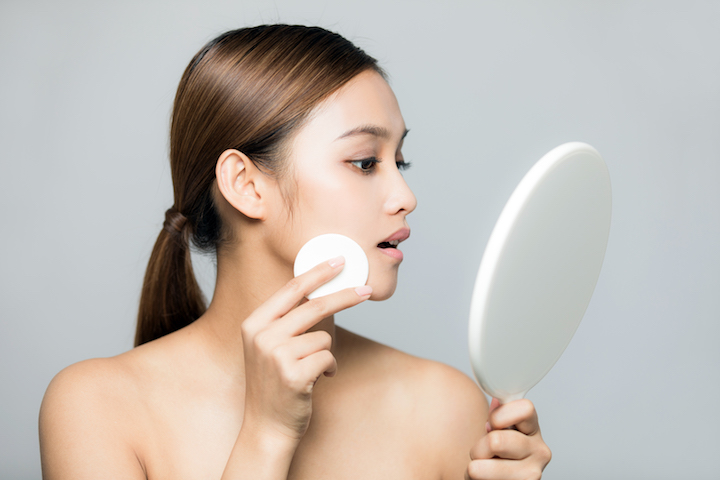The short answer: They may be. But then again, they may not be. Why the indecision? Because whether or not wait times really matter really depends on your skin. Find out whether you need to incorporate wait times in your acid exfoliation.
Acids. Unless you’re the sort of beauty enthusiast who makes bat noises of excitement when your delivery of glass test tubes arrives, terms like chemical exfoliation, AHA, BHA, and acids make most people nervous. If you’re one of them, that’s a natural reaction. Healthy, even.
To this day, “chemical peels” make me think of B-movie horrors melting after being exposed to holy water, despite me being one of those aforementioned beauty nerds who may be on some sort of federal watchlist due to making repeated purchases of scientific testing equipment.

Thankfully, not all acids are alike — you can explore their skincare benefits without risking a transformation into a comic book villain. Unless said villain is known for their smooth, luminous skin:
“With a tilt of her supple cheek into the light, the Shining Skin Siren blinds our hero with her radiant glow, and escapes in a cloud of facial mist!”

Acids can be a very gentle treatment for your skin, with leave-on, wash-off, and spot treatments as viable options depending on what suits your skin and needs. Despite their initial learning curve, acids are worth exploring as a step in your routine, as they have have scientific studies backing up their effectiveness for skin conditions ranging from acne to hyperpigmentation to aging. But there’s a lot of information out there, at times conflicting, about pH requirements, concentration, and wait times (the amount of time you wait after applying an acid and before applying the next treatment).
Here’s a simple 101 on wait times to get you started.
The short version
In fact, let’s get started with the shortest version ever:
Wait times don’t really matter. Go ahead and breathe a sigh of relief.
The long version
The longer version is that they sort of may possibly kinda matter, but because most scientific trials that study the use of acid exfoliants focus on concentrations and other parameters that aren’t practical (or available) for at-home use, there’s no clear-cut answer. So in the absence of direct science saying otherwise, wait times come down to personal preference. The concentration of your acids, your skin type, your skin troubles, and the sensitivity of your skin are all factors to consider.
The amount of free time you have to hang out with your acids is also a major factor, because not everyone looks forward to a leisurely evening applying one product at a time in long intervals. On the other hand, it makes for a great excuse to squeeze in another episode on Netflix. (Or K-dramas, because nothing inspires you to keep on your skincare routine like the Shining Skin Siren-level of glow sported by K-drama actors.)
Wait times might matter
The reason I personally leave acids on for 15-20 minutes before moving to other steps is due to my preference for gentler formulations that contain weaker concentrations of acids. Strong acids can get the job done quickly (peels are a great example) and can do so under less-than-optimal conditions, but you don’t need to go all in on acids with both guns blazing to see results.
By using gentler acids but allowing them unhindered time to work on your skin, it’s logical that you’re getting more benefit than if you slapped on said gentle acid and immediately diluted and/or negated it by applying another product on top of it. Some people choose to stack their acids by applying two kinds (for example, BHA and AHA) in quick succession, but using multiple acids in a routine is a shortcut to over-exfoliation if you’re just starting out.

If you find your gentle acids are a bit too gentle, you can try boosting them by using a pH-adjusting toner beforehand to bring your skin to an optimally acid-friendly state, or experiment with adding a wait time before moving onto your next product.
As someone with oily, dehydrated, and clog-prone skin, I find that after 20 minutes of BHA exfoliation, a film of dead skin, sebum, and stray pore clogs has appeared on my skin. I like to gently wipe this layer of goo away with toner on a cotton square, so my face is clean and ready for my next skincare steps. By immediately moving onto the next steps without waiting, I’m missing an opportunity to cleanse the aforementioned impurities from my skin.
Then again, they might not
Not everyone has the same skin concerns, and not every method works for everyone. Your skin may have no issue with impurities, which take time to surface, or your products may be stronger, or you may simply not have the time. There are plenty of reasons why wait times may not be necessary, and they may not be needed at all.
Since there are no studies (as yet) that specifically test wait times in the concentrations found in over-the-counter acid exfoliants, there’s nothing proving it matters either way. Since our skin is influenced by so many factors (genetics, climate, environment, health, habits, personal skin triggers), even science can only get you so far when it comes to how your skin will respond.

Trial and error, unfortunately, is unavoidable on one’s personal skincare journey. You may find that your skin doesn’t need an extended wait time for your acid exfoliant to do its job, or you may find that it needs time to exorcise the skin demons haunting your pores.
The important thing is to go slowly and cautiously with chemical exfoliants, because it’s easy to overdo them and suffer the pangs (or rather sting) of over-exfoliation. If you’re completely new to acid exfoliation, (first read this primer) then try the shortest, simplest application: Apply immediately after cleansing, then move on to your next steps directly afterwards. The next product will help buffer your skin from the effects of the acid or stop it completely.
Too many skin troubles, not enough time?
If you’re short on time but need to budge stubborn pore clogs, rough texture, or hyperpigmentation, you don’t have to go with the slow-cooker style method of gentle acids with a long wait time. It turns out that you can take your skin for a wild ride, then screech to a halt and eject it from the passenger seat before it has time to panic. At least, in theory. (No promises on the state of its hair afterwards.)
There is a technique called “Short Contact Therapy” (SCT), which involves taking strong actives (usually prescription) and applying them for a short period of time, and then washing the product off to stop the process. As these stronger actives are usually highly irritating, the SCT method helps to dodge most of the irritation while still imparting the skin benefits of using them.

While the studies focus on very irritating actives like prescription-strength retinoids, we can apply this same method to acid exfoliation, using the milder concentrations available in over-the-counter products. If you find your chemical exfoliant is too irritating to leave on for an extended time, you could experiment with the SCT method and wash it off after a brief period.
Follow what works for you
Ultimately, wait times may be a way for you to scale up the intensity and effectiveness of your chemical exfoliants, allowing you more flexibility in their concentration, but there’s no scientific data to support mandatory wait times.
Whether the gentle-and-slow or intense-and-fast approach to acid wait times works better for your skin and schedule, always be safe. Wear strong, full-spectrum sunscreen daily, and be attentive to your skin’s needs. Using acid exfoliants, especially AHAs (alpha hydroxy acids) can make your skin more vulnerable to sun damage, either through photosensitization or simply by exposing your new, more delicate skin layers to the elements.
Even if sun damage isn’t your sworn nemesis, take a page from the Shining Skin Siren’s master plan and always wear sunscreen.
Have any questions or comments on wait times? Do you follow wait times? Let us know in the comments, or share this article on your Beauty Wall and see what your friends think!
Loading...
